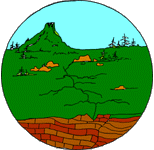|
SCIENCE STANDARDS
1. Students should learn why there are many
different types of volcanic rocks. They should know obsidian, scoria, and
pumice. They should become familiar with other volcanic rocks like basalt
and andesite.
2. Students should be able to distinguish which lava
originally had gas released by observing which rocks are more holey.
3. Students should be able to compare books on
whether they can relate scientific information within a story compared to
a book that presents just the information.
4. Students should be able to distinguish a
seismogram (the paper) with a seismograph (the instrument).
5. Students should be able to define a seismogram as
a pictorial representation of the different waves that are generated by
earthquakes.
6. Students should be able to define a seismic wave
as energy released by an earthquake.
7. Students should be begin to realize that large
earthquakes can cause considerable damage.
8. Students should know that earthquakes and
volcanoes occur throughout the world, but are usually concentrated in
certain areas.
9. Students should begin to recognize that
earthquakes and volcanoes are the data that geologists use to interpret
where there are plate boundaries.
10. Students should begin to question models of how
the Earth's outer surface moves.
11. Students should begin to see the differences and
similarities with earthquake and volcanic hazards.
12. Students should be able to determine why viscous
material that flows down a volcanic mountain can cause damage.
OVERVIEW OF FIFTH GRADE
VOLCANOES
WEEK 1.
PRE: Exploring the rocks produced by volcanoes.
LAB: Comparing igneous rocks.
POST: Critiquing books on volcanoes for their scientific content.
EARTHQUAKES
WEEK 2.
PRE: Analyzing the types of waves produced by earthquakes.
LAB: Interpreting seismograms with associated damages.
POST: Analyzing earthquakes around the world.
PLATE TECTONICS
WEEK 3.
PRE: Investigating the patterns
produced by volcanoes and earthquakes.
LAB: Testing models of crustal movement.
POST: Defining plate boundaries.
HAZARDS
WEEK 4.
PRE: Comparing volcanic and
earthquake hazards.
LAB: Determining what type of viscous mixtures can cause the most
damage.
POST: Exploring earthquakes that are associated with volcanoes.
|

 Plate
Tectonic
Plate
Tectonic